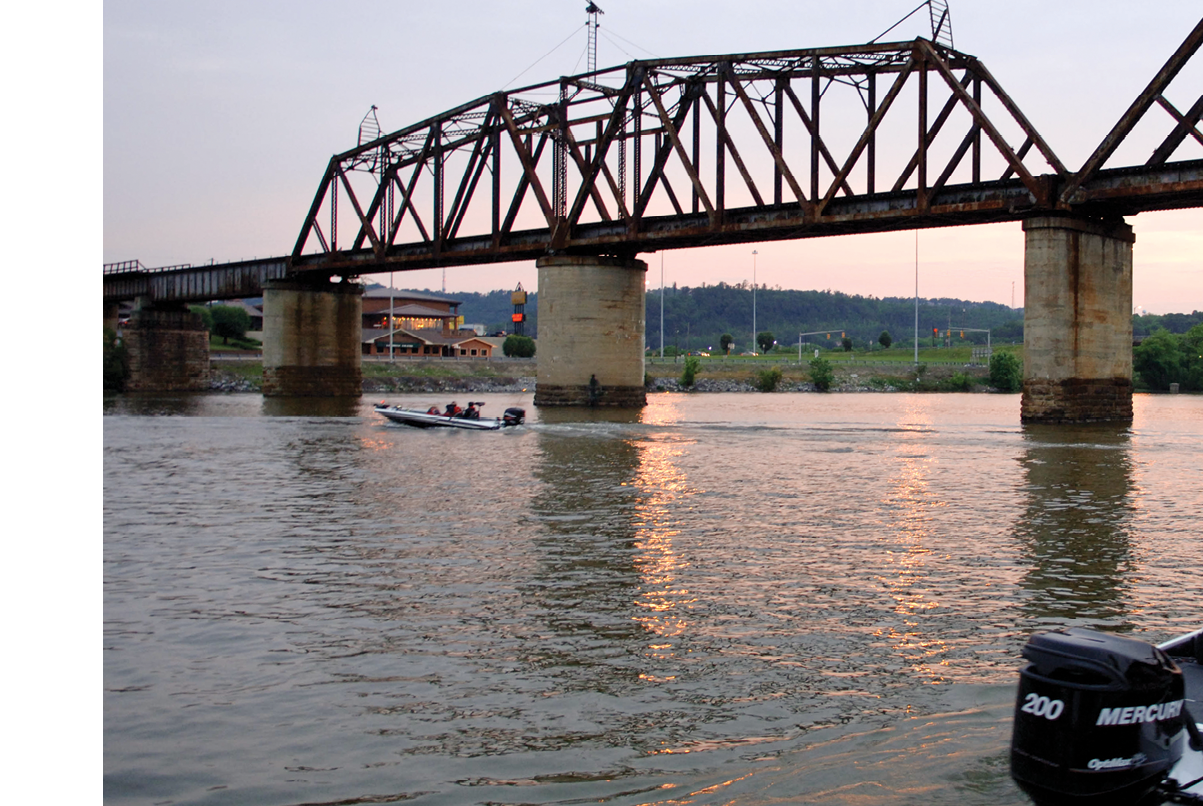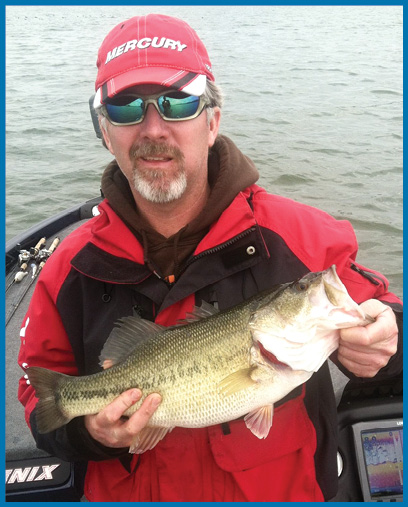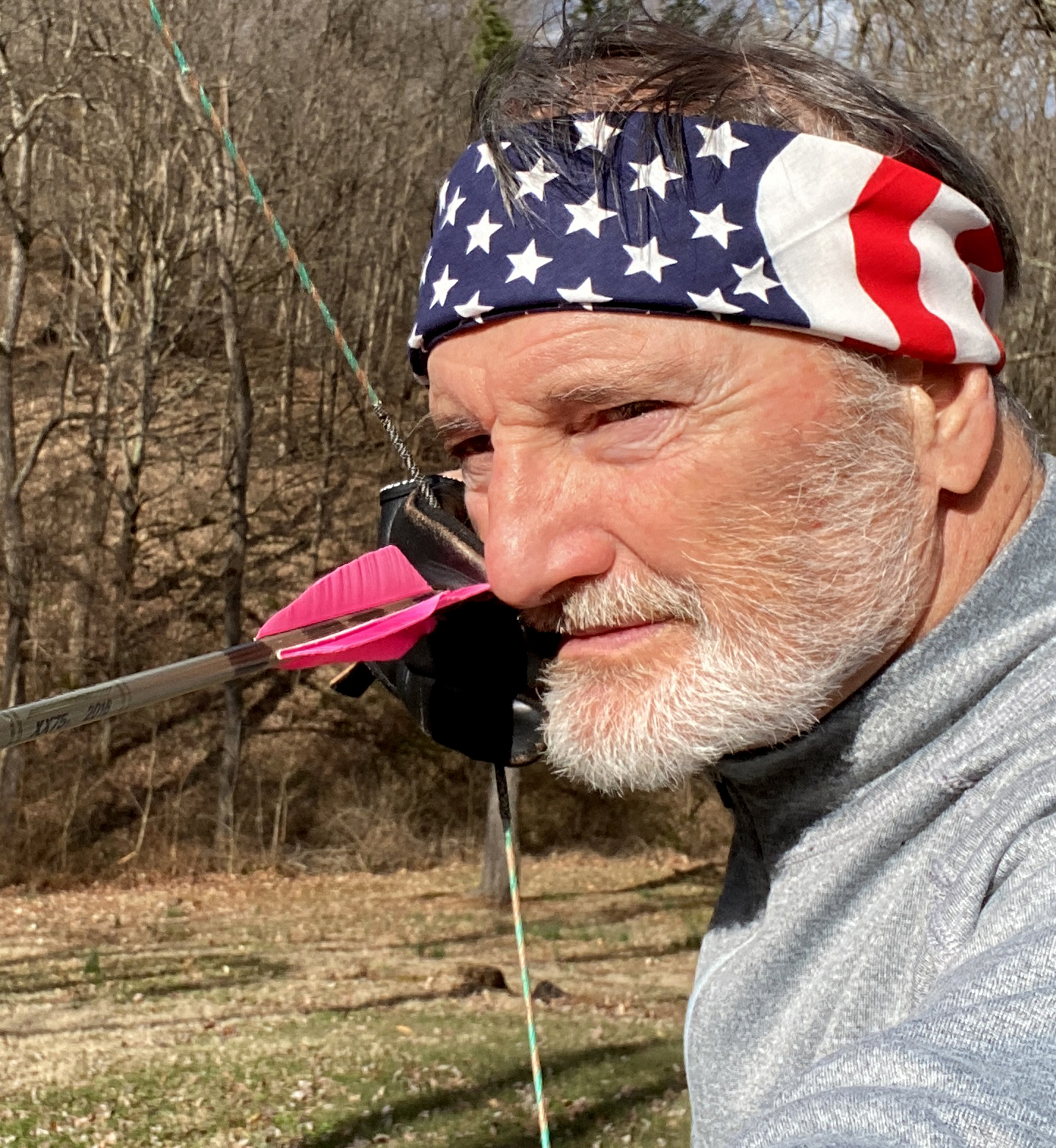
Neely Henry Lake attracts throngs of Alabama bass fishermen, but visitors from out of state tend to overlook it. One reason for this is that the enormous largemouth bass in Lake Guntersville swim just a short cast to the north of Neely Henry.
Although lunker largemouth are scarce at Neely Henry, it harbors an exceptional trophy spotted bass fishery. Add that the lake ranks third statewide in angler success, and you begin to understand Neely Henry’s local popularity.
There are typically three weeknight pot tournaments at Neely Henry spring through fall, plus bigger events on the weekends, claims local bass nut Jason Grape. Grape lives minutes away from the lake and has fished it intensely for nearly three decades. “Some of the bigger tournaments draw 200 boats,” Grape says. “It makes for crowded fishing, but everybody still catches them.”
That this relatively small 11,235-acre reservoir withstands such pressure and continues to produce excellent catch rates is a testament to its fertility.
TUNING IN
As good as the fishing can be here, you must tune into Neely Henry’s quirks or you’ll struggle to get bites. A river-run lake, Neely Henry winds 77.6 miles upstream from the H. Neely Henry hydroelectric dam to the Weiss Lake dam. From Weiss Lake down, much of Neely Henry’s length is the narrow, winding Coosa River. Neely Henry begins to widen south of Gadsden.
“One thing that’s well known to local fishermen is that it’s hard to pattern bass on Neely Henry,” Grape says. “It’s a run-and-gun junk fishing lake.”
Frequent fluctuations in the lake level and current flow keep Neely Henry’s bass on the move as they follow baitfish. You may be catching a bass on every cast for 20 minutes and then they’re gone, Grape points out.
Although spotted bass are the predominant species, largemouth do win tournaments at Neely Henry. This is especially so in the spring when spawning activities pull them shallow. April and early May are typically the best times to tangle with largemouth here.
The largemouth flock to docks and waterwillows, known locally as Coosa River grass, which grows in the shallows. The waterwillows in Canoe Creek should be on your hit list when you fish Neely Henry in springtime. The most consistent largemouth tactic is swimming a jig through the waterwillows and tight to boat docks.
MAGNUM COOSA RIVER SPOTS
 When Grape fishes Neely Henry in May, he starts the day casting for spotted bass. His goal is to sack 15 to 18 pounds of spots and then search for a kicker largemouth or two in the shallows. “This lake is known for its tremendous Coosa River spotted bass that weigh 3 to 5 pounds,” Grape says. “You’d better be ready for a fight. A 2-pound Coosa River spot pulls like a 5-pound largemouth.”
When Grape fishes Neely Henry in May, he starts the day casting for spotted bass. His goal is to sack 15 to 18 pounds of spots and then search for a kicker largemouth or two in the shallows. “This lake is known for its tremendous Coosa River spotted bass that weigh 3 to 5 pounds,” Grape says. “You’d better be ready for a fight. A 2-pound Coosa River spot pulls like a 5-pound largemouth.”
Magnum spotted bass may be caught from one end of Neely Henry to the other, and they are already schooling by mid-May, Grape claims. However, they are easier to catch in the lower, wider end of the lake because it has more obvious bass structure. Grape targets long points, gravel bars, rocky banks, sea walls and boat houses.
In May, the spotted bass are hanging in the 6- to 12-foot range, Grape points out. He catches some of his bigger spots at this time with a Rebel Pop-R and Lucky Craft’s dog-walking Sammy stickbait. When the spots won’t come up for a topwater offering, Grape gets down to them with crankbaits, including the Rapala Shad Rap, Strike King 3XD and Bandit 200.
“My favorite bait is 3/8- or 1/2-ounce brown or black-and-blue jig with a Zoom Chunk or a NetBait Paca Craw,” Grape says.
The long, narrow, upriver reach of Neely Henry offers bass little in the way of diversity. You might think this would simplify things, but Grape claims that the fishing h
ere is unpredictable. Pitching jigs and soft plastic baits to bluff banks and fallen trees might be hot one day and cold the next.
Grape has his best luck upriver fishing “potholes” in the bottom that range from 6 to 20 feet deep.
“When they’re in the potholes, I make a milk run and hit every one I know about,” Grape says. “You might catch only a few spots on the way upstream, but on the way back you might catch a bass on every cast from a hole you fished earlier.”
Slow rolling a 3/4- or 1-ounce Strikezone Ledgebuster spinnerbait over the potholes pulls big spotted bass up for Grape. His other go-to baits are shad color Strike King 5XD and 6XD crankbaits.
“Once you catch a big spot anywhere on this lake, there are usually more with it,” Grape says. “When the bite stops, leave and come back later and you’ll catch more of them. I’ve done well in tournaments by fishing and refishing the same three holes all day long.”
MEET JASON GRAPE
From his home in Attalla, Ala., Jason Grape can be at Neely Henry Lake in minutes. He has been catching bass from this Coosa River reservoir for nearly 30 of his 41 years. “I’m usually fishing there two or three times a week for fun or in a tournament,” Grape says. Grape’s knowledge of Neely Henry is the reason he regularly earns a check when he fishes a tournament.
GPS COORDINATES
The Alabama Power Company has improved the fishing at Neely Henry Lake by planting fish habitat. You can get GPS coordinates to these sweet spots here: www.alabamapower.com/lakes/fishdata.asp.
GO HERE FIRST
Before you visit Neely Henry or any Alabama reservoir, go to www.alabamabasstrail.org. Here you’ll find detailed information about nine lakes and two major river systems, including fishing locations, productive fishing patterns, local guides, campgrounds and where to stay.





